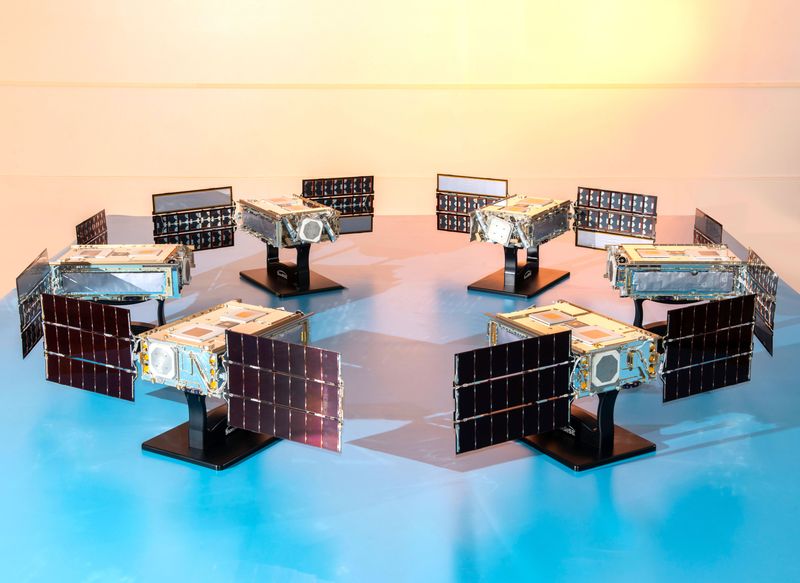
SDL’s SunRISE program manager Tim Neilsen and engineers Cameron Weston and Ryan Martineau pose behind the fleet of six completed SunRISE SmallSats at SDL facilities on USU’s Innovation Campus. Planned for launch later this year, SunRISE will provide new information about how energetic solar particles are produced and released. (Photo Credit: SDL/Allison Bills)
Utah State University’s Space Dynamics Laboratory has completed the design and manufacturing of six small satellites, or SmallSats, for NASA’s Sun Radio Interferometer Space Experiment, known as SunRISE.
Planned for launch later this year, SunRISE will represent a significant advancement in our understanding of solar phenomena and their effects on space weather. With a mass of 12 kilograms each, the six identical SmallSats measure just 36 centimeters by 24 centimeters by 12 centimeters — about the size of a typical desktop computer. Orbiting Earth, they will operate in unison as a single large radio telescope to study solar activity, focusing on low radio frequency emissions produced during large eruptive events at the Sun known as coronal mass ejections and solar flares.
SunRISE will enable scientists to understand better how these eruptive events produce extremely energetic particles. In addition to contributing to fundamental knowledge about the Sun, these studies may help scientists understand how similar processes work elsewhere in the universe. Mission planners may be able to use information from SunRISE to assess potential hazards to spacecraft and astronauts and improve space weather forecasts significantly.
The SunRISE SmallSats will fly within approximately 10 kilometers of one another just above geosynchronous orbit, at an altitude of approximately 36,000 kilometers. Conducting the observations in space is crucial since the ionosphere, an upper layer of Earth’s atmosphere, reflects and absorbs low radio frequencies, preventing measurements of these solar radio emissions from the ground. Each SunRISE SmallSat carries an innovative radio receiver payload. Working together, the SmallSats will create 3-D maps of the low radio frequency emissions generated by the energetic particles. With these maps, the SunRISE team will pinpoint the origins of intense radiation bursts and understand their triggers, acceleration processes, and evolution.
SunRISE also will use these 3-D maps to track how low radio frequency emissions evolve as the energetic particles move along magnetic fields extending from the Sun outward into interplanetary space. This aspect of the mission will provide unprecedented insights into the magnetic structures and how they influence energetic particles as they propagate through space.
“We are honored to be part of this important mission that exemplifies NASA’s quest to advance our understanding of solar dynamics and the implications for space weather,” said Tim Neilsen, SDL’s program manager for SunRISE. “With this novel approach of using a formation of small satellites as a unified radio telescope, SunRISE will unveil critical aspects of solar radio emissions and energetic particle processes, enhancing our capabilities in space weather forecasting and contributing to the safety and success of future space exploration missions.”
SunRISE is led by Professor Justin Kasper at the University of Michigan in Ann Arbor and is managed by NASA’s Jet Propulsion Laboratory in Southern California.
SunRISE is a Mission of Opportunity under the Heliophysics Division of NASA’s Explorers Program Office. The Explorers Program is the oldest continuous NASA program designed to provide frequent, low-cost access to space using principal investigator-led space science investigations relevant to the Science Mission Directorate’s (SMD) astrophysics and heliophysics programs. The Explorers Program is managed for SMD by NASA’s Goddard Space Flight Center in Greenbelt, Maryland, which conducts a wide variety of research and scientific exploration programs for Earth studies, space weather, the solar system, and the universe.
Headquartered on Utah State University’s Innovation Campus in North Logan, UT, the Space Dynamics Laboratory is a nonprofit organization and a Department of Defense University Affiliated Research Center owned by USU. More than 1,000 dedicated SDL engineers, scientists, business professionals, and student employees solve technical challenges faced by the military, science community, and industry and support NASA’s vision to explore the secrets of the universe for the benefit of all. SDL has field offices in Albuquerque, NM; Chantilly, VA; Dayton, OH; Huntsville, AL; Ogden, UT; and Stafford, VA. For more information, visit www.sdl.usu.edu.

Contact
- SDL Public Relations
- 435-713-3054
- pr@sdl.usu.edu